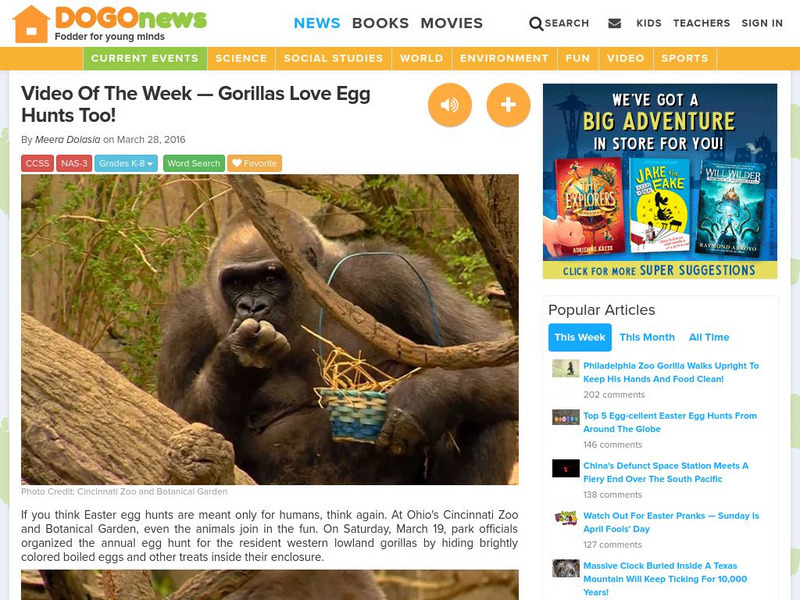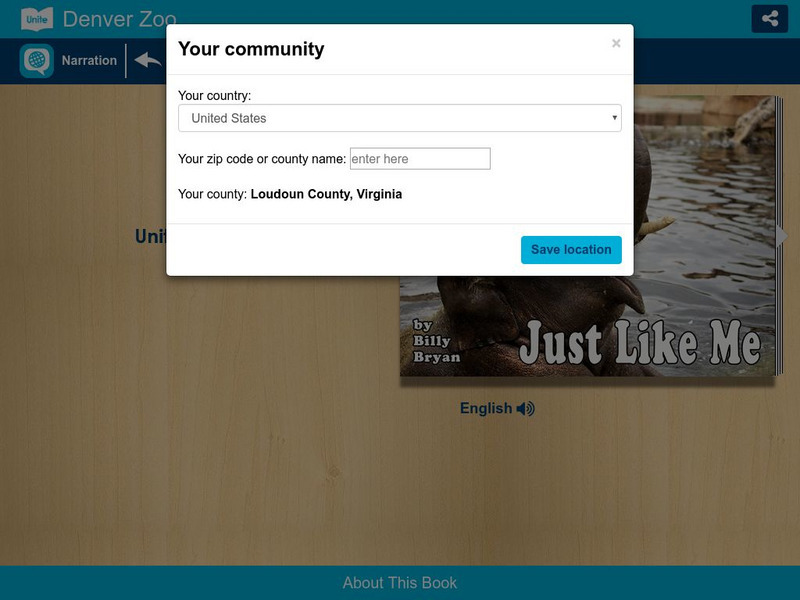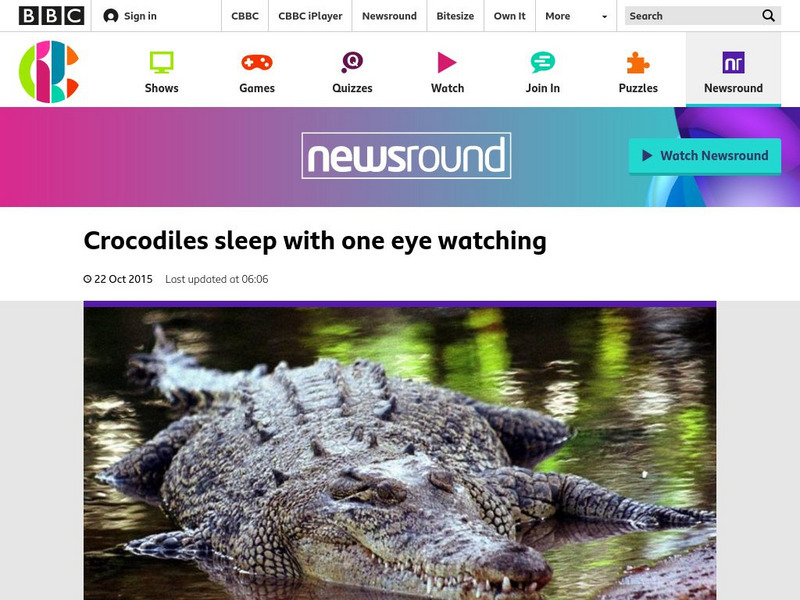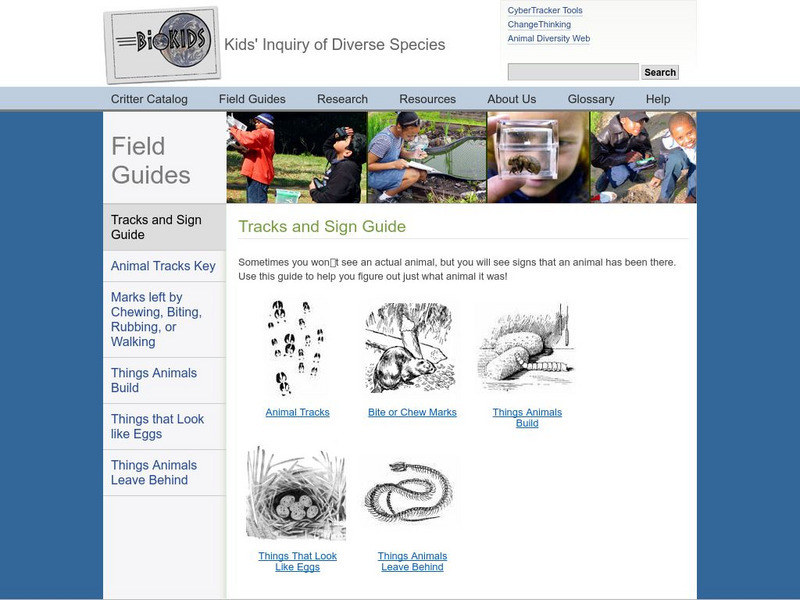DOGO Media
Dogo News: Why Crafty Crocodiles May Be Sleeping With Eye Open
New research on the sleeping behavior of crocodiles. Includes video.
Seeker
Seeker: Animal Pairs Prove Love Is Blind
View incredible photos of friendships between animals of different species.
Other
Aaas Science News: Week of 2 24 14: Elephants Console Each Other
Article reports on findings from a recent study that elephants display empathy and console one another when upset. This behavior was previously thought to be unique to apes and humans. Includes a brief video [0 mins, 50 sec].
DOGO Media
Dogo News: Week of 4 4 16: Gorillas Love Egg Hunts Too!
Photos and video of a gorilla enjoying an Easter egg hunt at a zoo in Cincinnati. Includes video.
CNN
Cnn: Student News April 23, 2014
News program reports on the current events of the day. Includes a video, transcript and critical analysis questions.
Unite for Literacy
Unite for Literacy: Animals: Small and Mighty Mammals
Learn about some of the special skills some small mammals have. Includes audio narration in Turkish and English, with text in English.
Unite for Literacy
Unite for Literacy: Denver Zoo: Conservation: Just Like Me
Learn about the habits of different zoo animals and how they are like human children. Includes audio narration in nine additional languages with text in English.
Science Buddies
Science Buddies: Dog Toys: What Makes One a Favorite or a Flop to Fido?
It seems as though dogs, like people, have definite preferences for their play things. This fun project investigates what makes a toy interesting to a dog. In these experiments, you and your dog can have some fun while you learn about...
BBC
Bbc Newsround: Crocodiles Sleep With One Eye Watching
Brief article reports on new research into how crocodiles sleep.
PBS
Nh Pbs: Nature Works: Communication
This comprehensive site describes how communication is an adaptation that is important for survival.
Better Lesson
Better Lesson: Who's Your Animal Parent?
Do all animal babies look like their parents? Let's explore animal babies and find out the answer to this scientific question! Learners will explore animal parents and animal babies through a matching game. Included in this activity are...
BBC
Bbc Newsround: Dogs Copy Each Other's Emotions
Read about the ways in which dogs express basic empathy and engage in social bonding.
PBS
Pbs Nova: Wild Wolves
What's in a wolf's howl -- a calling card, a warning, or an invitation? Hear the call of the wild, find out how wolves are making a comeback, and discover the ancient connection between dogs and wolves in this feature exhibit.
PBS
Pbs Learning Media: Tracking Polar Bears
In this interactive activity adapted from the USGS Alaska Science Center, students will track the movements of a polar bear as it migrates across the changing Arctic sea ice and compare the paths of four different polar bears.
University of Illinois
University of Illinois Extension: Urban Text: Adventures of Herman the Worm
WORMS- What are they? Where did they come from? If you are interested in Herman the Worm's family tree (biologically speaking), his body structures, or all the facts about him that you'll ever need, go to "The Adventures of Herman the...
Utah Education Network
Uen: Plant and Animal Changes
Second graders will learn about animal adaptation, hibernation, and migration.
Annenberg Foundation
Annenberg Learner: Journey North: A Global Study of Wildlife Migration and Seasonal Change
Here you can view maps showing the migratory paths of dozens of animals across the northern hemisphere, report a sighting of one of the animals listed in the database, and much more.
University of Michigan
University of Michigan: Animal Sign Guide
Use this guide to help you identify signs from different animals in the wilderness. Identify tracks, chew marks, signs from animals that build, eggs, and the like.
PBS
Pbs Learning Media: How Animals Care for Their Young
In this interactive lesson, students learn that animals take care of their young in many of the same ways the adults in their lives take care of them. Students watch videos from NATURE and engage in a variety of activities to check...
PBS
Pbs Learning Media: How Animals Care for Their Young
In this interactive lesson, students learn that animals take care of their young in many of the same ways the adults in their lives take care of them.
Other
Ocean Tracks: Fact or Artifact? Interpreting Patterns in Ocean Tracks Data [Pdf]
Ever wonder where marine animals go? How fast they swim? How deep they dive? Electronic tagging has opened a new window into the world of the open ocean. Ocean Tracks gives you access to data collected by tags on real live migrating...
PBS
Pbs Learning Media: Wild Kratts: Graphic Organizers (English)
Channel your inner 'Creature Power' while watching Wild Kratts! Dig deep into the video clips using these learning resources.
PBS
Pbs Learning Media: Wild Kratts: Graphic Organizers (Spanish)
Canaliza tu "Poder Animal" interno mientras que ves Wild Kratts! Investiga mas a fondo en los videos utilizando estos recursos de aprendizaje.
ArtsNow
Arts Now Learning: Magic Rocks [Pdf]
In this lesson, students work in groups with each acting as a predator, prey, or family member in a particular habitat. They present their habitat performance to the class and students identify the habitat and animal relationships. Then,...

















